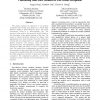Free Online Productivity Tools
i2Speak
i2Symbol
i2OCR
iTex2Img
iWeb2Print
iWeb2Shot
i2Type
iPdf2Split
iPdf2Merge
i2Bopomofo
i2Arabic
i2Style
i2Image
i2PDF
iLatex2Rtf
Sci2ools
ICPR
2000
IEEE
2000
IEEE
Constructing Finite State Machines for Fast Gesture Recognition
This paper proposes an approach to 2D gesture recognition that models each gesture as a Finite State Machine (FSM) in spatial-temporal space. The model construction works in a semi-automatic way. The structure of the model is first manually decided based on the observation of the spatial topology of the data. The model is refined iteratively between two stages: data segmentation and model training. Given the continuous training data of a single gesture, we roughly segment the gesture trajectory into phrases using the spatial information alone. The segmentation results are used to initialize an FSM. The model is used to re-segment the data. The results of the re-segmentation are used to refine the parameters of the model. After the FSM is trained, we incorporate a modified Knuth-Morris-Pratt algorithm into the FSM recognition procedure to speed up the gesture recognition. The computational efficiency of the FSM recognizers allows real-time on-line performance to be achieved.
Related Content
| Added | 09 Nov 2009 |
| Updated | 09 Nov 2009 |
| Type | Conference |
| Year | 2000 |
| Where | ICPR |
| Authors | Pengyu Hong, Thomas S. Huang, Matthew Turk |
Comments (0)

